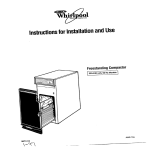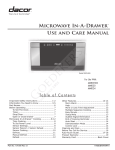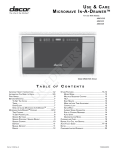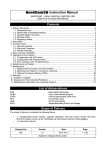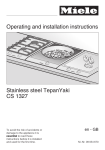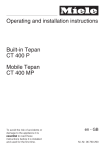Download Caple C995 Instruction manual
Transcript
GB Instruction manual for tepan Model code: C995 Contact Caple on 0844 800 3830 or for spare parts www.4caple.co.uk GUIDE TO APPLIANCE 1 Tepan plate 2 Indicators 3 Control for Tepan plate 1 0 1 2 9 3 8 4 7 6 5 3 2 2 - Indicators 0 2 9 3 8 4 4 In-operation indicator 5 Residual heat indicator 1 5 4 7 6 5 2 Dear Customer, We thank you and congratulate you on granting us your preference, by purchasing one of our products. We are sure that this new appliance, manufactured with quality materials, will meet your requirements in the best possible way. The use of this new equipment is easy. However, we invite you to read this booklet carefully, before installing and using the appliance. This booklet gives the right information on the installation, use and maintenance, as well as useful advice. CAPLE wARNING AND SAFETY INSTRUCTIONS This appliance complies with all relevant local and national safety requirements. Inappropriate use can, however, lead to personal injury and damage to property. To avoid the risk of accidents and damage to the appliance, please read these instructions carefully before using it for the first time. They contain important notes on installation, safety, use and maintenance. Keep these instructions in a safe place and ensure that new users are familiar with the content. Pass them on to any future owner. •This appliance is intended for domestic use only and may only be used as described in these instructions. Any other usage is at the owner’s risk and could be dangerous. The manufacturer cannot be held liable for damage resulting from incorrect or improper use or operation. •This appliance is not intended for use by persons (including children) with reduced physical, sensory or mental capabilities, or lack of experience and knowledge, unless they are supervised whilst using it, or have been given instruction concerning its use by a person responsible for their safety. •This appliance is not a toy! To avoid the risk of injury, keep children away from it at all times, and do not let them play with it or use the controls. They will not understand the potential dangers posed by it. They should be supervised whenever you are working in the kitchen. •Older children may use the appliance only when its operation has been clearly explained to them and they are able to use it safely, recognising the dangers of misuse. •The appliance gets hot when in use and remains hot for quite a while after being switched off. To safeguard against burning, keep children well away from the appliance at all times. •Do not store anything which might arouse a child’s interest in storage areas above or next to the appliance. Otherwise they could be tempted into climbing onto the appliance with the risk of burning themselves. Danger of burning. •Packaging, e.g. cling film, polystyrene and plastic wrappings, must be kept out of the reach of babies and young children. Danger of suffocation. Dispose of or recycle all packaging safely as soon as possible. •Installation, maintenance and repairs may only be carried out by a suitably qualified and competent person in strict accordance with current national and local safety regulations. Repairs and other work by unqualified persons could be dangerous. The manufacturer cannot be held liable for unauthorised work. •Before installation, check the appliance for visible signs of damage. Under no circumstances should you use it if it has been damaged. A damaged appliance is dangerous. •The electrical safety of this appliance can only be guaranteed when continuity is complete between the appliance and an effective earthing system which complies with current local and national safety regulations. It is most important that this basic safety requirement is present and tested regularly, and where there is any doubt the household wiring system should be inspected by a qualified electrician. The manufacturer cannot be held liable for the consequences of an inadequate earthing system (e.g. electric shock). •Before connecting the appliance to the mains supply, make sure that the voltage and frequency correspond to the rating on the data plate, otherwise the appliance could be damaged. This data must correspond in order to avoid the risk of damage to the appliance. Consult a qualified electrician if in any doubt. 3 wARNING AND SAFETY INSTRUCTIONS •Do not connect the appliance to the mains electricity supply by a multi-socket unit or an extension lead. These do not guarantee the required safety of the appliance (e.g. danger of overheating). •For safety reasons, this appliance may only be used when it has been built in. •This appliance may be connected via a fused plug and switched socket. If you wish to connect it to an isolator switch, or if the appliance is supplied without a plug, it must be installed and connected by a suitably qualified and competent person in strict accordance with current local and national safety regulations. The manufacturer cannot be held liable for damage caused by incorrect installation or connection. •If the connection cable is damaged, it must be replaced by a suitably qualified electrician with a special connection cable of type H05VV-F (pvc insulated). •Never open the casing of the appliance. Tampering with electrical connections or components and mechanical parts is highly dangerous to the user and can cause operational faults. •While the appliance is under guarantee, repairs should only be undertaken by a service technician authorised by the manufacturer. Otherwise the guarantee will be invalidated. •During installation, maintenance and repair work, the appliance must be disconnected from the mains electricity supply. It is only completely isolated from the electricity supply when: – the mains fuse is disconnected, – the screw-out fuse is removed (in countries where this is applicable), – it is switched off at the wall socket and the plug is withdrawn from the socket, or it is switched off at the isolator. •Faulty components must only be replaced by genuine Caple original spare parts. The manufacturer can only guarantee the safety of the appliance when Caple replacement parts are used. •In countries where there are areas which may be subject to infestation by cockroaches or other vermin, pay particular attention to keeping the appliance and its surroundings in a clean condition at all times. Any damage caused by cockroaches or other vermin will not be covered by the guarantee. •The appliance is hot when in use, and remains hot for quite a while after being switched off. Do not touch it whilst it could still be hot. •For added protection, it is advisable to use heat-resistant pot holders or gloves when using the appliance. Do not let them get damp or wet, as this causes heat to transfer through the material more quickly with the risk of scalding or burning yourself. •Do not heat up unopened tins or jars of food on the Tepan plate. as pressure will build up in the tin, causing it to explode. This could result in injury and scalding or damage. •Do not use the appliance to heat up the room. Due to the high temperatures radiated, objects near the appliance could catch fire. The life of the appliance could also be reduced. •This appliance must not be set up or operated in the open air. •Never leave the appliance unattended when using it. Overheated oil or fat can catch fire and could even set the cooker hood on fire. •If oil or fat catches fire, do not attempt to put out the flames with water. Use a suitable fire blanket, saucepan lid, damp towel or similar to smother the flames. •Do not use the appliance as a resting place for anything else. The article could melt or catch fire if residual heat is still present or if the appliance is switched on by mistake. •Do not cover the appliance, e.g. with a cloth, kitchen foil, etc. This could be a fire hazard if the appliance is switched on by mistake. •Do not flambé under a cooker hood. The flames could set the cooker hood on fire. •Always ensure that food is sufficiently cooked or reheated. Many factors will affect the overall cooking time, including the size and quantity of the food and its temperature. Some foods may contain micro organisms which are only destroyed by thorough cooking at a sufficiently high temperature for long enough. Therefore, when cooking or reheating food such as poultry, it is particularly important that the food is completely cooked through. If in doubt, select a longer cooking or reheating time. •Spray canisters, aerosols and other inflammable substances must not be stored in a drawer under the hob. Cutlery inserts must be heat-resistant. •Do not use plastic utensils on the appliance, as the Tepan plate gets very hot. Even heat-resistant plastic utensils are unsuitable. •When using an electric socket near the appliance, care should be taken that the cable of the electrical appliance does not come into contact with the hot appliance. The insulation on the cable could become damaged, giving rise to an electric shock hazard. The manufacturer cannot be held liable for damage caused by non-compliance with these Warning and Safety instructions. 4 CLEANING FOR THE FIRST TIME •Remove any protective foil and sticky labels. •Clean with a solution of washing up liquid in warm water, and dry with a soft cloth. Metal components have a protective coating which may give off a slight smell when heated up for the first time. The smell and any vapours will dissipate after a short time, and do not indicate a faulty connection or appliance. OPERATION Switching on and off To switch the Tepan plate on, turn the control clockwise. To switch off, turn the control anti-clockwise. Only turn the control clockwise as far as “9” and anti-clockwise back to “0” again to switch it off. Do not attempt to turn it all the way round from the “9” position to “0” or vice versa. This will damage the control. After the switching on the in-operation indicator light up. Residual heat indicator After switching off, the residual heat indicator lights up. The residual heat indicator remains on until the Tepan plate is cool enough to touch. Do not touch or place any heat sensitive objects on the Tepan plate while the residual heat display is still on. Danger of burning. Settings Cooking process Settings Keeping cooked food warm 1-2 Steaming fruit, e.g. apple slices, peach halves, sliced bananas, etc.. 2-4 Gentle stir frying of chopped/sliced vegetables, e.g. leeks, mushrooms, green/red peppers, onion etc.. 5 Cooking delicate fish 6 Cooking in succesion of meat, fish, fried eggs, pancakes etc. 7-8 Roast potato pancakes, prawns, cobs 9 These settings are only a guide. The actual cooking time will depend on the type of food, its texture and thickness as well as personal taste. 5 OPERATION Tips Wipe the surface of the Tepan plate before each use with a damp cloth to remove any dust particles or other soiling which may have settled on it since it was last used. •Pre-heat the Tepan plate thoroughly for 8 -10 minutes at the power level that you are going to be using for cooking. •It is important to get the Tepan sufficiently hot before use, particularly when browning and sealing meat. If it is not hot enough, the meat will lose too much juice and become tough. •For frying only use the minimum amount of oil or fat. With marinated food, no fat or oil is needed. Wait until the temperature indicator light has gone out before adding cooking fat. •Only use fats and oils which can be heated to high temperatures. •Marinating often improves the flavour of food to be cooked. •Pat wet food dry with kitchen paper before cooking to prevent it spitting. •To prevent meat drying out, do not season with salt until after it has been cooked. CLEANING AND CARE Do not use a steam cleaner to clean this appliance. The steam could reach the electrical components and cause a short circuit. Pressurised steam could also cause permanent damage to the surface and to other components, for which the manufacturer cannot accept liability. The appliance should be cleaned after each use. Let it cool down to room temperature. To avoid water marks and limescale deposits, use a soft cloth to dry surfaces that have been cleaned with water. To avoid damaging the surface of your appliance, do not use: – cleaning agents containing soda, alkalines, ammonia, acids or chlorides, – cleaning agents containing descaling agents, – stain or rust removers, – abrasive cleaning agents, e.g. powder cleaners and cream cleaners, – solvent-based cleaning agents, – dishwasher cleaner, – grill and oven cleaners, – glass cleaning agents, – hard, abrasive brushes or sponges, e.g. pot scourers, brushes or sponges which have been previously used with abrasive cleaning agents, – sharp pointed objects (these can damage the seal between the frame and the worktop). •Use a spatula to remove any large particles immediately. •Allow the appliance to cool down until it can be touched by hand, and then use a solution of hot water and washing-up liquid to soften the soiling. Remove the soiling with a spatula and then wipe the surface with a damp cloth. •Then clean the appliance thoroughly with a few drops of ceramic and stainless steel hob cleaner using a clean, damp cloth. Follow the instructions on the packaging. •Ensure that every trace of cleaner has been removed from the surface by wiping carefully with a damp cloth. Any remaining traces could affect food the next time you use the appliance. •Finally dry the appliance with a clean, soft cloth. Important - Conditioning agents for stainless steel must not be used on the Tepan plate. What to do if...? ... after switching on, the appliance does not heat up Check whether the mains fuse has tripped. If it has, contact a qualified electrician or the Customer Contact Centre. Installation work and repairs to electrical appliances must only be carried out by a suitably qualified and competent person in strict accordance with current local and national safety regulations. Repairs and other work by unqualified persons could be dangerous. The manufacturer cannot be held liable for unauthorised work. 6 SAFETY INSTRUCTIONS FOR INSTALLATION •Fit the wall units and extractor hood before fitting the Tepan to avoid damaging the surface. •The veneer or laminate coatings of worktops (or adjacent kitchen units) must be treated with 100 °C heat-resistant adhesive which will not dissolve or distort. Any backmoulds must be of heat-resistant material. •This appliance may only be used in mobile installations such as ships, caravans, aircraft etc. if a risk assessment has been carried out by a suitably qualified engineer. •Connection should be made via a suitable isolator or a double pole fused spur connection unit which complies with current national and local safety regulations, and the on/off switch should be easily accessible after the appliance has been built in. See “Electrical connection - Built-in Tepan” for more details. •The appliance must not be built in over a fridge, fridge-freezer, freezer, dishwasher, washing machine or tumble dryer. •After installation, ensure that the connection cable cannot come into contact with the underside of the appliance. Make sure that there is no mechanical obstruction, such as adrawer, which could damage it. •Observe carefully the safety distances given on the following pages. •Do not use any sealant except where expressly instructed to do so. The seal underneath the appliance provides a sufficient seal for the worktop (see “General installation tips”). All dimensions in this instruction booklet are given in mm. Safety distance above the Tepan A minimum safety distance must be maintained between the Tepan plate and the cooker hood above it. See the cooker hood manufacturer’s operating and installation instructions for details. If the manufactrer’s instructions are not available for the cooker hood, a minimum safety distance of at least 760 mm must be maintained. For any flammable objects, e.g. utensil rails, wall units etc. a minimum distance of at least 760 mm must be maintained between them and the appliance below. When two or more appliances are installed together below a cooker hood, e.g. a Tepan and a gas hob combiset, which have different safety distances given in the installation instructions, you should select the greater distance of the two 7 SAFETY INSTRUCTIONS FOR INSTALLATION Safety distances to the sides of the Tepan Ideally the appliance should be installed with plenty of space on either side. There may be a wall at the rear and a wall or a tall unit at one side. On the other side, however, no unit or divider should stand higher than the appliance. Due to the high temperatures radiated by the Tepan, it is essential that a minimum distance of 50 mm is maintained between the worktop cut-out and the back wall. The safety distance between the worktop cut-out and a wall or tall unit to the right or left of it is 50 mm. Recommended 50 mm 50 mm Not recommended Not allowed 8 SAFETY INSTRUCTIONS FOR INSTALLATION Safety distance when installing the appliance near a wall with additional niche cladding There must be a minimum distance of 50 mm between the niche cladding and the worktop cut-out. This distance is only necessary for niche cladding made of wood or any other combustible material. For non-combustible materials (metal, ceramic tiles or similar), this dimension can be reduced by the thickness of the niche cladding material. The materials can warp or distort when subjected to high temperatures. Example: thickness of the niche cladding 15 mm 50 mm - 15 mm = minimum distance 35 mm (1) Wall (2) Niche cladding measure x = thickness of the niche cladding (3) Worktop (4) Worktop cut-out (5) Minimum distance for combustible materials 50 mm for non-combustible materials 50 mm - measure x WORKTOP CUT-OUT DIMENSION 38 0 0 52 65 5 49 35 5 9 SAFETY INSTRUCTIONS FOR INSTALLATION Preparing the worktop •Make the worktop cut-out for one or more appliances as applicable. Remember to maintain a minimum safety distance from the back wall, as well as from any tall unit or side wall to the right or left of the Tepan. See «Safety instructions for installation». •Seal the cut surfaces with a suitable heat-resistant sealant to avoid swelling caused by moisture. The materials used must be resistant to high temperatures. General installation tips Worktop •Do not use sealant between the frame of the top part of the appliance and the worktop. •This could cause difficulties if it ever needs to be taken out for servicing and possibly result in damage to the frame or the worktop. •The sealing strip under the edge of the top part of the appliance provides a sufficient seal for the worktop. The slots (1) and the hatched area shown in the image must be smooth and perfectly flat because the frame of the hob supports good and the gasket under the lip can be applied to ensure sufficient stability. 10 SAFETY INSTRUCTIONS FOR INSTALLATION Electrical connection •We recommend to connect the appliance with an outlet. In this way the technical assistance interventions could be more simple. •Make sure the outlet is available even after the appliance was collected. •If the connection is not made by an electrical outlet, contact an electrician who is familiar with the additional local codes and regulations issued by the utility area. •The fitter may have to settle a switch in case the plug is no longer accessible after the built-in. •This device must be at a suitable opening distance from the contacts in order to allow the entire disconnection in case of overvoltage category III, in accordance with installation rules. •The informations about the connection are found in the technical label, whose indications must correspond to the electricity grid ones. The manufacturer cannot be held liable for damage which is the direct or indirect result of incorrect installation or connection. It also cannot be held liable for damage caused by failure or interruption of the grounding. After the installation every part of the appliance must be isolate so cannot happen accidents while the operation Absorbed power Look at technical label Connection and protection AC 230 V/ 50 Hz Overload switch 16 A Differential switch (safety switch) For more security we recommend to predispose a differential automatic switch (safety switch). Remove the appliance from the power grid To remove the appliance from the electric line proceed as described below: - Fuses Pull out the fuses from their supports, or: - Automatic protection Press the control button (red one) until comes out the central button (black one), or: - Protection from the embedding Move the switch from 1 (insertion) to 0 (disconnection), or: - Automatic differential switch (safety switch) Move the principal switch from 1 (ignition) to 0 (shut down) or press the control buttom After detachment make sure that the grid cannot be reinserted Replacement of the power cable In case of demagement of the power cable, it must be replaced with H 05 VV-F cable type. The replacement need to be installed by a Caple service agent. 11 This product complies with EU Directive 2002/96/EC. The manufacturing firm refuses all responsibility for any possible imprecision in this booklet, due to misprints or clerical errors. It reserves the right to make all the changes that it will consider necessary in its own products, without effecting the essential characteristics of functionality and safety. 12 COD. 208463 - 14.11.2011 The crossed-out dustbin symbol reported on the appliance indicates that the appliance must be disposed of separately from other domestic refuse at the end of its useful life. It must therefore be delivered to a waste recycling centre specifically for electric and electronic equipment or returned to the retailer at the moment of purchase of a new equivalent appliance. The user is responsible for delivering the appliance to the appropriate collection centre at the end of its useful life, Failure to do so may result in a fine, as provided for by laws governing waste disposal. Differential collection of waste products for eventual recycling, treatment and environmentally friendly disposal helps reduce possible negative effects on the environment and health, and also enables the materials making up the product to be recycled. For more detailed information on the available refuse collection systems, refer to the local Municipal Solid Waste disposal centre or the shop where the product was purchased. Producers and importers are responsible for fulfilling their obligations as regards recycling, treatment and environmentally friendly disposal by directly or indirectly participating in the collection system.












